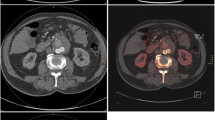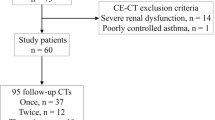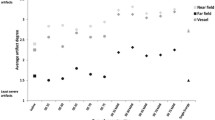Abstract
Purpose
This study was done to evaluate the possibility of reducing the dose of ionising radiation by using dual-source dual-energy computed tomography (CT) in patients undergoing CT angiography of the aorta to search for endoleaks after endovascular aneurysm repair (EVAR).
Materials and methods
One hundred and forty-eight patients (117 M, 31 F; mean age 75 ± 6.5) underwent 171 CT angiography scans for follow-up after EVAR. For each patient we performed a triple-phase acquisition protocol consisting of a nonenhanced phase, an arterial phase and a delayed phase; the latter acquired in dual energy. Two radiologists jointly evaluated the nonenhanced, arterial and delayed phase, and a third radiologist evaluated only the delayed phase and its virtual noncontrast (VNC) reconstruction. Moreover, we compared the cumulative effective doses of the triple-phase acquisition with the dual-energy acquisition.
Results
We detected 34 endoleaks (19.8 %), with 100 % agreement between the triple-phase and dual-energy acquisitions. The effective dose of dual-energy acquisition performed during the delayed phase was 61.7 % lower than that of the triple-phase acquisition.
Conclusions
A dual-energy CT scan acquired during the delayed phase and its VNC reconstruction allow detection of endoleaks with a substantial reduction of effective dose and a complete diagnostic agreement with a triple-phase acquisition protocol.



Similar content being viewed by others
References
Fleming C, Whitlock EP, Beil TL et al (2005) Screening for abdominal aortic aneurysm: a best-evidence systematic review for the preventive services task force. Ann Intern Med 142:203–211
Sterpetti AV, Cavallaro A, Cavallari N et al (1991) Factors influencing the rupture of abdominal aortic aneurysms. Surg Gynecol Obstet 173(3):175–178
Hatakeyama T, Shigematsu H, Muto T (2001) Risk factors for rupture of abdominal aortic aneurysm based on three-dimensional study. J Vasc Surg 33:453–461
Eefting D, Ultee KH, Von Meijenfeldt GC et al (2013) Ruptured AAA: state of the art management. J Cardiovasc Surg 54(Suppl 1):47–53
Karkos CD, Sutton AJ, Bown MJ et al (2011) A meta-analysis and metaregression analysis of factors influencing mortality after endovascular repair of ruptured abdominal aortic aneurysms. Eur J Vasc Endovasc Surg 42:775–786
Görich J, Rilinger N, Sokiranski R et al (1999) Leakages after endovascular repair of aortic aneurysms: classification based on findings at CT, angiography and radiography. Radiology 213:767–772
Iezzi R, Cotroneo AR, Filippone A et al (2006) Multidetector-row CT in abdominal aortic aneurysm treated with endovascular repair: are unenhanced and delayed phase enhanced images really effective for endoleak detection? Radiology 241:915–921
Iezzi R, Cotroneo AR, Marano R et al (2008) Endovascular treatment of thoracic aortic diseases: follow-up and complications with multidetector computed tomography angiography. Eur J Radiol 65:365–376
Stavropoulos SW, Charagundla SR (2007) Imaging techniques for detection and management of endoleaks after endovascular aortic aneurysm repair. Radiology 243:641–655
Mancuso M, Pasquali E, Leonardi S et al (2008) Oncogenic bystander radiation effects in patched heterozygous mouse cerebellum. Proc Natl Acad Sci USA 105:12445–12450
Clevert DA, Minaifar N, Kopp R et al (2009) Imaging of endoleaks after endovascular aneurysm repair (EVAR) with contrast-enhanced ultrasound (CEUS). A pictorial comparison with CTA. Clin Hemorheol Microcirc 41:151–168
Macari M, Chandarana H, Schmidt B et al (2006) Abdominal aortic aneurysm: can the arterial phase at CT evaluation after endovascular repair be eliminated to reduce radiation dose? Radiology 241:908–914
Chandarana H, Godoy MC, Vlahos I et al (2008) Abdominal aorta: evaluation with dual-source dual-energy multidetector CT after endovascular repair of aneurysms–initial observations. Radiology 249:692–700
Johnson TR, Krauss B, Sedlmair M et al (2007) Material differentiation by dual energy CT: initial experience. Eur Radiol 17:1510–1517
Fayngersh V, Passero M (2009) Estimating radiation risk from computed tomography scanning. Lung 187:143–148
Motta R, Rubaltelli L, Vezzaro R et al (2012) Role of multidetector CT angiography and contrast-enhanced ultrasound in redefining follow-up protocols after endovascular abdominal aortic aneurysm repair. Radiol Med 117:1079–1092
Carrafiello G, Recaldini C, Laganà D et al (2008) Endoleak detection and classification after endovascular aneurysm treatment of abdominal aortic aneurysm: value of CEUS over CTA. Abdom Imaging 33:357–362
Nyheim T, Staxrud LE, Rosen L et al (2013) Review of postoperative CT and ultrasound for endovascular aneurysm repair using Talent stent graft: can we simplify the surveillance protocol and reduce the number of CT scans? Acta Radiol 54:54–58
Collins JT, Boros MJ, Combs K (2007) Ultrasound surveillance of endovascular aneurysm repair: a safe modality versus computed tomography. Ann Vasc Surg 21:671–675
Clevert DA, Minaifar N, Weckbach S et al (2008) Color duplex ultrasound and contrast-enhanced ultrasound in comparison to MS-TC in the detection of endoleak following endovascular aneurysm repair. Clin Hemoreol Microcirc 39:121–132
Giannoni MF, Fanelli F, Citrone M et al (2007) Contrast ultrasound imaging: the best method to detect type II endoleak during endovascular aneurysm repair follow-up. Interact Cardiovasc Thoracic Surg 6:259–262
Napoli V, Bargellini I, Sardella SG et al (2004) Abdominal aortic aneurysm: contrast-enhanced US for missed endoleaks after endoluminal repair. Radiology 233:217–225
van der Laan MJ, Bartels LW, Viergever MA et al (2006) Computed tomography versus magnetic resonance imaging of endoleaks after EVAR. Eur J Vasc Endovasc Surg 32:361–365
Pitton MB, Schweitzer H, HHerber S et al (2005) MRI versus helical CT for endoleak detection after endovascular aneurysm repair. AJR Am J Roentgenol 185:1275–1281
Scaglione M, Pinto A, Pinto F et al (2001) Role of contrast-enhanced helical CT in the evaluation of acute thoracic aortic injuries after blunt chest trauma. Eur Radiol 11:2444–2448
Görich J, Rilinger N, Söldner J et al (1999) Endovascular repair of aortic aneurysm: treatment of complications. J Endovasc Surg 6:136–146
Wolf YG, Tillich M, Lee WA et al (2002) Changes in aneurysm volume after endovascular repair of abdominal aortic aneurysm. J Vasc Surg 36:305–309
El Batti S, Cochennec F, Roudot-Thoraval F (2013) Type II endoleaks after endovascular repair of abdominal aortic aneurysm are not always a benign condition. J Vasc Surg 25:S0741–S5214
Patatas K, Ling L, Dunning J et al (2012) Static sac size with a type II endoleak post-endovascular abdominal aortic aneurysm repair: surveillance or embolization? Interact Cardiovasc Thorac Surg 15:462–466
Saba L, Montisci R, Sanfilippo R et al (2009) Imaging of the endoleak after endovascular aneurysm repair procedure by using multidetector computer tomography angiography. J Cardiovasc Surg 50:515–526
Ron E (2003) Cancer risks from medical radiation. Health Phys 85:47–59
Berrington de Gonzalez A, Darby S (2004) Risk of cancer from diagnostic X-rays: estimates for the UK and 14 other countries. Lancet 363:345–351
Brenner DJ, Hall EJ (2007) Computed tomography: an increasing source of radiation exposure. N Engl J Med 357:2277–2284
Sommer WH, Graser A, Becker CR et al (2010) Image quality of virtual non-contrast images derived from dual energy CT angiography after endovascular aneurysm repair. J Vasc Interv Radiol 21:315–321
Stolzmann P, Frauenfelder T, Pfammatter T et al (2008) Endoleaks after endovascular abdominal aortic aneurysm repair: detection with dual-energy dual-source CT. Radiology 249:682–691
Brägelmann A, Bunck A, Donas K et al (2013) Dual-energy CT in the follow-up after endovascular abdominal aortic aneurysm repair. Rofo 185:351–357
Conflict of interest
Vitaliano Buffa, Antonio Solazzo, Valeria D’Auria, Alessandra Del Prete, Andrea Vallone, Monica Luzietti, Manuela Madau, Roberto Grassi, Vittorio Miele declare no conflict of interest.
Author information
Authors and Affiliations
Corresponding author
Rights and permissions
About this article
Cite this article
Buffa, V., Solazzo, A., D’Auria, V. et al. Dual-source dual-energy CT: dose reduction after endovascular abdominal aortic aneurysm repair. Radiol med 119, 934–941 (2014). https://doi.org/10.1007/s11547-014-0420-1
Received:
Accepted:
Published:
Issue Date:
DOI: https://doi.org/10.1007/s11547-014-0420-1




